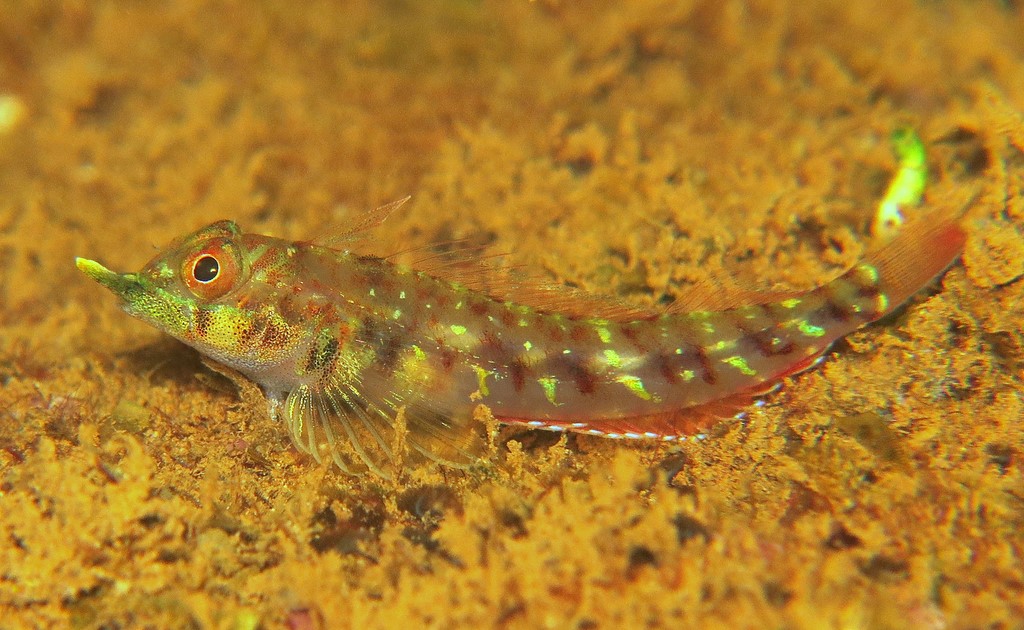HELCOGRAMMA RHINOCEROS - (HANSEN, 1986)
Picture courtesy of: Alain Daoulas
Actinopterygii (Gigaclass) > Actinopteri (Class) > Teleostei (Subclass) > Blenniiformes (Order) > Blennioidei (Suborder) > Tripterygiidae (Family) > Tripterygiinae (Subfamily) > Helcogramma (Genus)
Rhino threefin, Rhinoceros triplefin, Tengu-hebigimpo, テングヘビギンポ, 銼角彎線鳚,
Description
First dorsal spines: 3; Dorsal spines (total): 14-15 (usually: 15); Dorsal soft rays (total): 10-12 (usually: 11); Anal spine: 1; Anal soft rays: 19-20 (usually: 20); Vertebrae: 37. Orbital tentacle simple; Cephalic sensory pores moderately complex; Mandibular pore series: 4-5 + 1 + 4-5; Lateral line pores: 18-21; Lateral line ending under 11th-13th dorsal-fin elements; Nape naked. Upper lip with proboscis-like extension on males. Max. length: 4.0 cm TL. Depth range: 0 - 6 m.
Color
Trunk without longitudinal stripes; Head with horizontal yellowish or bluish white line from the upper rim of upper jaw to opercle. Males are easily recognized by the extended nose and change color to display to females with an electric blue line below the eye, shaded by black below.
Etymology
Helcogramma: etymology not explained, perhaps from Greek, helcium = a yoke or collar (harness around the neck of draft animals) + from Greek, gramma = a letter, any writing, a document or record a note of hand, bill, bond, account, written acknowledgement of a debt a letter, an epistle the sacred writings. Possibly referring to lateral line of Helcogramma decurrens, which differs from that of Tripterygion by running “downwards from the shoulder to the middle of the side instead of extending backward parallel with the back”. This unusual lateral line running down the neck may have reminded McCulloch & Waite of that type of equipment, which was still in use when the genus was described.
rhinoceros: named rhinoceros because the prolongation of the upper lip of males is reminiscent of the snout horn of rhinoceri (Latin).
Original description: Helcogramma rhinoceros Hansen, 1986 - Type locality: Cuyo Island, northwestern side of Putuic Island, 10°55'05"N, 121°02'03"E, Palawan Province, Philippines, depth 0-15 feet, collected by V. G. Springer, 22 may 1978.
Distribution
Indo-West Pacific: East Andaman Sea, Vietnam, Indonesia, Ryukyu Islands (Japan), Philippines, Taiwan, Solomon Islands, Vanuatu and New Caledonia.
Biology
Adults inhabit clear coastal reefs with algae covered rocky boulders, usually in small groups. They occur in very shallow depths on rock surfaces and under ledges. Eggs are hemispherical and covered with numerous sticky threads that anchor them in the algae on the nesting sites. Larvae are planktonic which occur primarily in shallow, nearshore waters.
Similar species
Helcogramma melanolancea (Tashiro & Motomura, 2018) - Reported from Bali, Indonesia.
Last update: 20, June 2022
Actinopterygii (Gigaclass) > Actinopteri (Class) > Teleostei (Subclass) > Blenniiformes (Order) > Blennioidei (Suborder) > Tripterygiidae (Family) > Tripterygiinae (Subfamily) > Helcogramma (Genus)
Rhino threefin, Rhinoceros triplefin, Tengu-hebigimpo, テングヘビギンポ, 銼角彎線鳚,
Description
First dorsal spines: 3; Dorsal spines (total): 14-15 (usually: 15); Dorsal soft rays (total): 10-12 (usually: 11); Anal spine: 1; Anal soft rays: 19-20 (usually: 20); Vertebrae: 37. Orbital tentacle simple; Cephalic sensory pores moderately complex; Mandibular pore series: 4-5 + 1 + 4-5; Lateral line pores: 18-21; Lateral line ending under 11th-13th dorsal-fin elements; Nape naked. Upper lip with proboscis-like extension on males. Max. length: 4.0 cm TL. Depth range: 0 - 6 m.
Color
Trunk without longitudinal stripes; Head with horizontal yellowish or bluish white line from the upper rim of upper jaw to opercle. Males are easily recognized by the extended nose and change color to display to females with an electric blue line below the eye, shaded by black below.
Etymology
Helcogramma: etymology not explained, perhaps from Greek, helcium = a yoke or collar (harness around the neck of draft animals) + from Greek, gramma = a letter, any writing, a document or record a note of hand, bill, bond, account, written acknowledgement of a debt a letter, an epistle the sacred writings. Possibly referring to lateral line of Helcogramma decurrens, which differs from that of Tripterygion by running “downwards from the shoulder to the middle of the side instead of extending backward parallel with the back”. This unusual lateral line running down the neck may have reminded McCulloch & Waite of that type of equipment, which was still in use when the genus was described.
rhinoceros: named rhinoceros because the prolongation of the upper lip of males is reminiscent of the snout horn of rhinoceri (Latin).
Original description: Helcogramma rhinoceros Hansen, 1986 - Type locality: Cuyo Island, northwestern side of Putuic Island, 10°55'05"N, 121°02'03"E, Palawan Province, Philippines, depth 0-15 feet, collected by V. G. Springer, 22 may 1978.
Distribution
Indo-West Pacific: East Andaman Sea, Vietnam, Indonesia, Ryukyu Islands (Japan), Philippines, Taiwan, Solomon Islands, Vanuatu and New Caledonia.
Biology
Adults inhabit clear coastal reefs with algae covered rocky boulders, usually in small groups. They occur in very shallow depths on rock surfaces and under ledges. Eggs are hemispherical and covered with numerous sticky threads that anchor them in the algae on the nesting sites. Larvae are planktonic which occur primarily in shallow, nearshore waters.
Similar species
Helcogramma melanolancea (Tashiro & Motomura, 2018) - Reported from Bali, Indonesia.
Last update: 20, June 2022
